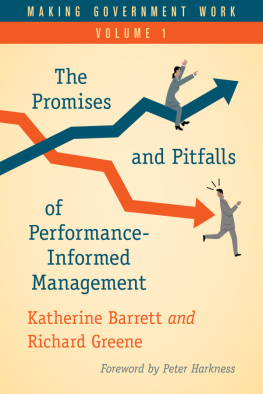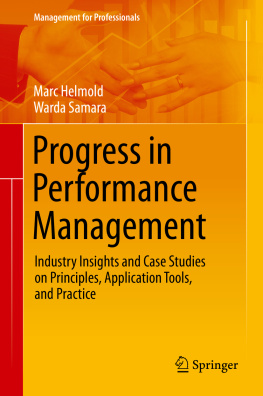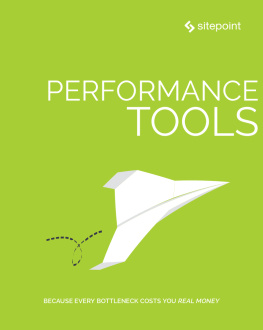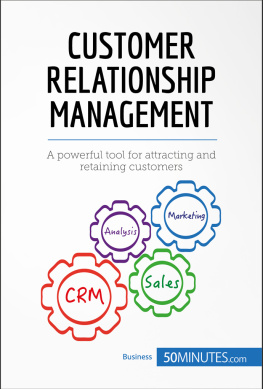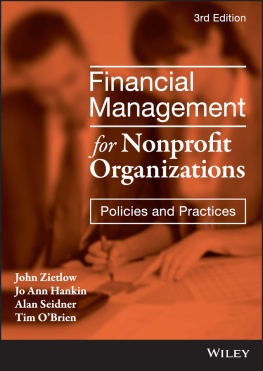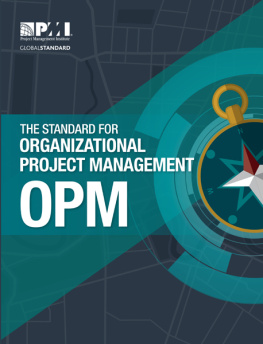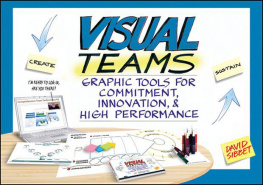We want to acknowledge and thank the many people who helped make this book possible. There are far more than we could list, but we thankfully acknowledge our many clients and members of the Beyond Budgeting Round Table (BBRT) for providing real companies in which we could see how performance management tools work on the front lines of business. We especially thank the volunteer BBRT membership chairmen, Steve Morlidge of Unilever and Bjarte Bogsnes of Statoil, for their support and diligent efforts in building the Round Table. We also thank our fellow BBRT directors, Peter Bunce and Franz Rsli, who have helped in the development of the ideas in this book and who share the load and make our time together more enjoyable. We would also like to thank retired director Robin Fraser, but he probably doesnt want his name in a book about tools.
We greatly appreciate the encouragement, friendship, and leadership of our academic advisor, Charles Horngren. Even though he has recently passed away, his guidance has permanently shaped our view of the world.
Our back office support team keeps us going wherever we are in the world, so special thanks to the North America team of Robin Baumgartner, Heather Bryce, Sandy Wilson, Melissa Rosandich, Pierre Guillaume, Ron Bradley, John Miller and Cynthia Thomas. We also want to thank those thought leaders who have helped shape our views, especially Mark Graham Brown and Stephen M.R. Covey.
We have been blessed with a great publishing team at Harvard Business Review Press. This includes Tim Sullivan, Kevin Evers, Allison Peter, and Jen Waring. We also want to thank our excellent research assistants, our sons Oliver Hope and Dave Player, who helped us at times when no one else could.
Our travels in pursuit of information for this book have taken us around the globe many times. The strength to make these journeys comes from the support of our families, who stand behind us and support us wherever we go. So our most heartfelt thanks go to Dot, Ben, Vicky, and Oliver Hope, and to Lydia, Dave, Emily, and Michael (Cole) Player, and also to Tony Hope and Ray and Lynnette Player. Your love sustains us.
Jeremy Hope and Steve Player
What is this practice and how effective is it?
Mission statements have become popular in recent years as managers look to build a high-performance culture. The trouble is that most focus on lofty goals and meaningless words rather than inspiring people with a compelling reason for being and core values that build their emotional commitment. Consequently, despite the time and effort involved, people end up ignoring most of them. We will look at how the best organizations deal with these problems and inspire their people.
Alternative names and related topics: corporate governance; business ethics; emotional commitment
How an organization defines its purpose and defines and articulates its goals influences how its people think, behave, and act in any given situation. Many organizations have focused their purpose and goals on making money or maximizing shareholder value rather than building great businesses and satisfying stakeholders, including employees, customers, and the wider community. The shareholder value model is rooted in traditional economic thinking. The model assumes that individuals are self-interested, rational decision makers driven by economic goals, and that economic relationshipswith employees, suppliers, customers, and external partnersare governed by binding contracts. In the industrial age, most people didnt need to understand their companys purpose; they simply did what was specified on their job descriptions and what their bosses told them to do.
In this model, the senior executive officers are agents of the owners, who act as stewards for the owners capital and are hired and paid to invest it wisely and grow its value over successive years. If they succeed, they are well rewarded, but if they fail, their jobs are on the line. Most large corporations have mission statements filled with words such as shareholder value, customer service, and product quality. And of course every chairmans report pays homage to the firms employees, who are usually the companys greatest assets. But despite pandering to other stakeholders, most executive teams know that it is increasing shareholder value that will keep them in their jobs.
Businesses and great relationships
Businesses that are most profitable and are able to sustain profits in the long run are actually those that build great relationships with customers, employees and suppliers. On the other hand, businesses that are most profit-oriented, like Enron, Bear Stearns and Lehman Brothers, are not in the long run profitable because they are pulled apart by the greed of their own employees.John Kay, business economist
Source: Vivek Kaul, Profit Cant Be Primary Goal of Business, DNA India , June 19, 2010, www.dnaindia.com/opinion/interview_profit-can-t-be-primary-goal-of-business_1398327 .
But is the explicit pursuit of shareholder value the best way to actually achieve it? Not according to British economist John Kay. He believes that great organizations are not exclusively profit oriented.
Take the case of ICI, Britains leading industrial company for most of the twentieth century. Its original purpose was about the responsible application of chemistry to business. The company began in dyes and explosives and then moved into new chemical businesses like fertilizers, petrochemicals, and finally into pharmaceuticals, all in the pursuit of applying chemistry to business in different ways as the needs of the wider economy changed. But in the 1990s, the company very explicitly abandoned that kind of goal in favor of shareholder value. Leaders disposed of many of their traditional businesses and bought a range of new ones, and paid too much for the businesses they bought. The company declined rapidly and disappeared altogether in 2007 (the business was sold to the Dutch company, Akzo Nobel). So not only did the responsible application of chemistry create a better business than did the attempts at increasing value; it also created more shareholder value. So its a process of adapting, a very loose general idea, to changing particular circumstances over time, noted Kay.
When Citicorp merged with Travelers in 1999 to create the sprawling bank conglomerate Citigroup, the joint CEOs held a press conference. John Reed, Citicorps CEO, declared, The model I have is of a global consumer company that really helps the middle class with something they havent been served well by historically. Thats my vision. Thats my dream. His joint-CEO, Travelers Sandy Weill, rapidly interjected, My goal is increasing shareholder value. Reed and his old-fashioned, oblique way of running a business was sidelined. Just a few years later, Citi was in trouble and Weill was forced out; within a decade, Citigroup was forced into the arms of the U.S. government.


